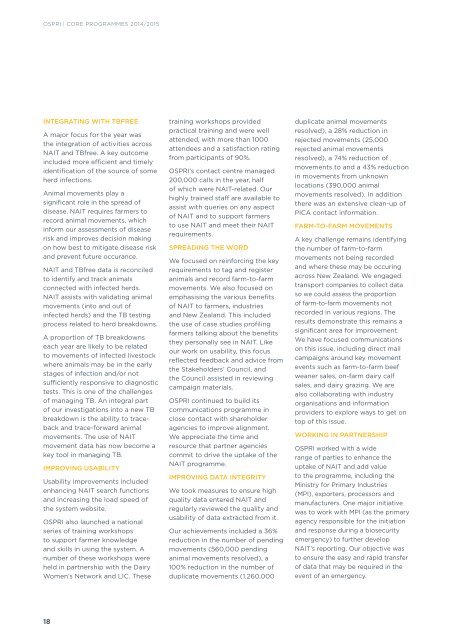Create successful ePaper yourself
Turn your PDF publications into a flip-book with our unique Google optimized e-Paper software.
OSPRI | CORE PROGRAMMES <strong>2014</strong>/<strong>2015</strong><br />
INTEGRATING WITH TBFREE<br />
A major focus for the year was<br />
the integration of activities across<br />
NAIT and TBfree. A key outcome<br />
included more efficient and timely<br />
identification of the source of some<br />
herd infections.<br />
Animal movements play a<br />
significant role in the spread of<br />
disease. NAIT requires farmers to<br />
record animal movements, which<br />
inform our assessments of disease<br />
risk and improves decision making<br />
on how best to mitigate disease risk<br />
and prevent future occurance.<br />
NAIT and TBfree data is reconciled<br />
to identify and track animals<br />
connected with infected herds.<br />
NAIT assists with validating animal<br />
movements (into and out of<br />
infected herds) and the TB testing<br />
process related to herd breakdowns.<br />
A proportion of TB breakdowns<br />
each year are likely to be related<br />
to movements of infected livestock<br />
where animals may be in the early<br />
stages of infection and/or not<br />
sufficiently responsive to diagnostic<br />
tests. This is one of the challenges<br />
of managing TB. An integral part<br />
of our investigations into a new TB<br />
breakdown is the ability to traceback<br />
and trace-forward animal<br />
movements. The use of NAIT<br />
movement data has now become a<br />
key tool in managing TB.<br />
IMPROVING USABILITY<br />
Usability improvements included<br />
enhancing NAIT search functions<br />
and increasing the load speed of<br />
the system website.<br />
OSPRI also launched a national<br />
series of training workshops<br />
to support farmer knowledge<br />
and skills in using the system. A<br />
number of these workshops were<br />
held in partnership with the Dairy<br />
Women’s Network and LIC. These<br />
training workshops provided<br />
practical training and were well<br />
attended, with more than 1000<br />
attendees and a satisfaction rating<br />
from participants of 90%.<br />
OSPRI’s contact centre managed<br />
200,000 calls in the year, half<br />
of which were NAIT-related. Our<br />
highly trained staff are available to<br />
assist with queries on any aspect<br />
of NAIT and to support farmers<br />
to use NAIT and meet their NAIT<br />
requirements.<br />
SPREADING THE WORD<br />
We focused on reinforcing the key<br />
requirements to tag and register<br />
animals and record farm-to-farm<br />
movements. We also focused on<br />
emphasising the various benefits<br />
of NAIT to farmers, industries<br />
and New Zealand. This included<br />
the use of case studies profiling<br />
farmers talking about the benefits<br />
they personally see in NAIT. Like<br />
our work on usability, this focus<br />
reflected feedback and advice from<br />
the Stakeholders’ Council, and<br />
the Council assisted in reviewing<br />
campaign materials.<br />
OSPRI continued to build its<br />
communications programme in<br />
close contact with shareholder<br />
agencies to improve alignment.<br />
We appreciate the time and<br />
resource that partner agencies<br />
commit to drive the uptake of the<br />
NAIT programme.<br />
IMPROVING DATA INTEGRITY<br />
We took measures to ensure high<br />
quality data entered NAIT and<br />
regularly reviewed the quality and<br />
usability of data extracted from it.<br />
Our achievements included a 36%<br />
reduction in the number of pending<br />
movements (560,000 pending<br />
animal movements resolved), a<br />
100% reduction in the number of<br />
duplicate movements (1,260,000<br />
duplicate animal movements<br />
resolved), a 28% reduction in<br />
rejected movements (25,000<br />
rejected animal movements<br />
resolved), a 74% reduction of<br />
movements to and a 43% reduction<br />
in movements from unknown<br />
locations (390,000 animal<br />
movements resolved). In addition<br />
there was an extensive clean-up of<br />
PICA contact information.<br />
FARM-TO-FARM MOVEMENTS<br />
A key challenge remains identifying<br />
the number of farm-to-farm<br />
movements not being recorded<br />
and where these may be occuring<br />
across New Zealand. We engaged<br />
transport companies to collect data<br />
so we could assess the proportion<br />
of farm-to-farm movements not<br />
recorded in various regions. The<br />
results demonstrate this remains a<br />
significant area for improvement.<br />
We have focused communications<br />
on this issue, including direct mail<br />
campaigns around key movement<br />
events such as farm-to-farm beef<br />
weaner sales, on-farm dairy calf<br />
sales, and dairy grazing. We are<br />
also collaborating with industry<br />
organisations and information<br />
providers to explore ways to get on<br />
top of this issue.<br />
WORKING IN PARTNERSHIP<br />
OSPRI worked with a wide<br />
range of parties to enhance the<br />
uptake of NAIT and add value<br />
to the programme, including the<br />
Ministry for Primary Industries<br />
(MPI), exporters, processors and<br />
manufacturers. One major initiative<br />
was to work with MPI (as the primary<br />
agency responsible for the initiation<br />
and response during a biosecurity<br />
emergency) to further develop<br />
NAIT’s reporting. Our objective was<br />
to ensure the easy and rapid transfer<br />
of data that may be required in the<br />
event of an emergency.<br />
18


